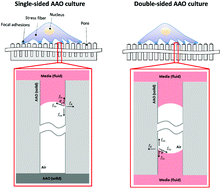Dependence of cell adhesion on extracellular matrix materials formed on pore bridge boundaries by nanopore opening and closing geometry†
Abstract
In this study, we report experimental results for characterization of the growth and formation of pore bridge materials that modified the adhesion structures of cells cultured on nanomembranes with opening and closing geometry. To perform the proof-of-concept experiments, we fabricated two types of anodized alumina oxide substrates with single-sided opening (i.e., one side open, but closed at the other side) and double-sided opening (i.e., both sides open). In our experiment, we compared the densities of pores formed and of bridge materials which differently act as connective proteins depending on the size of pores. The results show that the pore opening geometry can be used to promote the net contact force between pores, resulting in the growth and formation of pore bridge materials before and after cell culture. The results also imply that the bridge materials can be used to attract the structural protrusion of filopodia that can promote the adhesion of cell-to-cell and cell-to-pore bridge. It is observed that the shape and size of cellular structures of filopodia depend on the presence of pore bridge materials. Overall, this observation brought us a significant clue that cells cultured on nanopore substrates would change the adhesion property depending on not only the formation of nanopores formed on the surface of topological substrates, but also that of pore bridge materials by its morphological growth.



 Please wait while we load your content...
Please wait while we load your content...